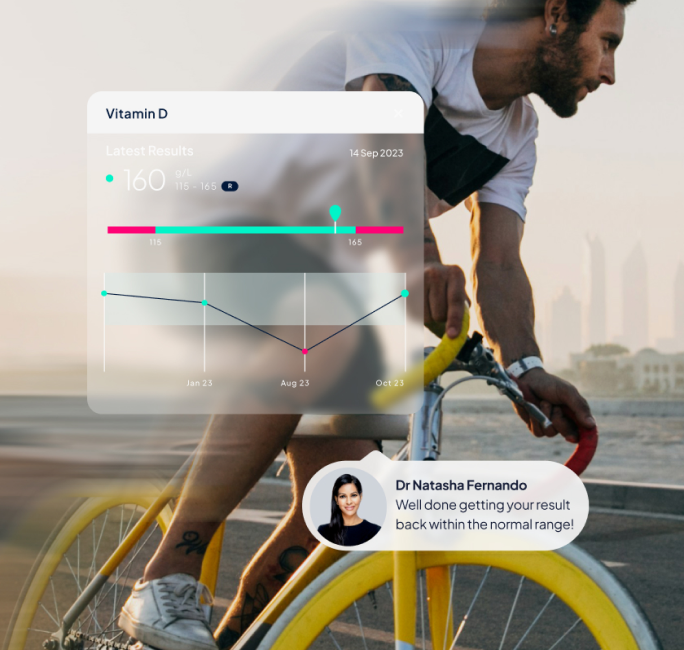Are you getting the right balance of healthy fats? Omega-3 and omega-6 fatty acids play a crucial role in heart health, brain function, and inflammation control, but an imbalance can contribute to chronic inflammation and cardiovascular risk. This test measures your omega-3 and omega-6 levels, along with your Omega-3 Index, to help you optimise your diet for better health.

Go beyond the numbers
Get ready to elevate your health understanding with a personalised doctor's report. Go beyond results and tap into expert insights tailored just for you.
- Actionable advice
- Expert support
- Tailored recommendations

How it works
You have the flexibility to choose what works best for you. Enjoy the comfort of having a friendly nurse visit your home for a quick blood draw, opt for a convenient visit to one of our nationwide partner clinics, or self-arrange a draw at a location that suits you.
Take control of your health with Medichecks – order your blood test today!

Track, improve, and monitor your health over time.
MyMedichecks is your personal online dashboard where you can view your results, access clear and simple explanations about individual health markers, monitor changes in your health, and securely store information about your medical history, lifestyle and vital statistics.
What's in the test?
Omega fatty acids
ARA : EPA
Learn more
Omega-3 essential fatty acids such as EPA are responsible for controlling inflammation, brain development, and regulating blood pressure. Omega-6 fatty acids such as ARA are thought to have a pro-inflammatory role in the body, while omega-3 fatty acids like ERA are thought to have an anti-inflammatory role.
Omega 3 index
Learn more
How to prepare for your test
Prepare for your Omega 3 and 6 Blood Test by following these instructions.
Fasting and hydration
- For most accurate omega fatty acid results, do not eat or drink anything other than water for 12 hours prior to your test. If you take medication then you are allowed to take it as you would normally.
Medications and supplements
- If you take omega-3 supplements, wait until after your test to take them.
Test limitations
Reviews
FAQs
What's a good omega-6 to omega-3 ratio and Omega-3 Index?
Our test looks at your ratio of the omega-6 fatty acid, arachidonic acid (ARA), to the omega-3 fatty acid, eicosapentaenoic acid (EPA). There's no consensus on an optimal omega-6 to omega-3 ratio. Generally, it's best to aim for a result that’s as low as possible. The Omega-3 Index is more well-defined, with a result of 8% or above putting you in a lower-risk category.
Western diets are associated with higher levels of ARA compared to EPA. A higher ratio may increase the risk of inflammation and chronic health conditions, such as cardiovascular disease, type 2 diabetes, and other inflammatory and autoimmune diseases.
The good news is that making changes to your diet can help improve your levels and reduce these risks.
What foods are omega-3 and omega-6 found in?
There are many sources of omega-6 fatty acids including most vegetable oils, red meat, poultry, eggs, leafy green vegetables, and nuts. In contrast, omega-3s are found in a much smaller number of foods, such as oily fish, flaxseeds, and walnuts. The omega-3 fatty acids, EPA and DHA, which are measured in the Omega-3 Index, are mainly found in algae and oily fish such as salmon and mackerel.
As your body is unable to make omega-3 and omega-6 fatty acids by itself, they must be taken in directly through the food you eat. And, due to the smaller number of dietary sources, many people don’t get enough omega-3 fatty acids, which makes testing your levels so important.
What do omega-3 and omega-6 essential fatty acids do?
Essential fatty acids are vital for the normal functioning of your body systems, including supporting your immune system, regulating blood pressure, and keeping your brain healthy. They’re known as polyunsaturated fats and can help lower the level of bad cholesterol in your blood.
Omega-3 fatty acids are considered particularly healthy fats — they can help to reduce inflammation and protect your body against heart disease. There’s lots of research supporting the benefits of two particular omega-3 fatty acids — eicosapentaenoic acid (EPA) and docosahexaenoic acid (DHA) — in supporting heart, brain, joint, and eye health.
Omega-6s are also good for you, in moderation. However, they’re thought to be pro-inflammatory. Although inflammation helps protect your body from injury and infection, it can cause damage and disease when it becomes chronic (long-term) and excessive. A healthy balance of omega-3s and omega-6s has the potential to keep this type of inflammation in check.
What are the benefits of omega-3 fatty acids?
Omega-3 has anti-inflammatory properties and may help to support the circulation and immune system. Increasing omega-3 intake has been associated with an improvement in certain signs and symptoms, such as:
-Fatigue and muscle weakness
-Poor attention and/or concentration
-Depression
-Dry eyes
-Dry skin, brittle hair, and thin nails
What can I do to improve my levels?
If the results of your omega blood test are outside of the healthy ranges, you may be able to make improvements with changes to your diet. This should include reducing the amount of omega-6-rich food you eat, while boosting your sources of omega-3s.
If you want to improve your Omega-3 Index, you’ll need to boost your intake of EPA and DHA. Oily fish, like salmon and mackerel, is one of the best sources. But if you don’t eat fish, you can increase your intake of algae like seaweed, nori, spirulina, and chlorella.
You may also be recommended to take a supplement, such as an omega-3-rich fish oil or algae supplement. If so, follow your doctor’s advice carefully.
Are all omega-6 fatty acids bad?
Research suggests that not all omega-6s cause inflammation and some may even be anti-inflammatory. Also, not all omega-3s may be equally as good for you as one another. Some sources of omega-6 are healthier than others, such as sesame and avocado oils, which contain lower levels of omega-6 than sunflower oil.
Can I take an omega-3 test at home?
Yes, you can do an omega check with our at-home omega-3 blood test. We’ll send you everything you need including our omega-3 test kit and a pre-paid return envelope for your sample.
How can I test for omega-3 at home?
Our essential fatty acids test includes a full lab analysis of your sample. You can view the results of your omega test on your MyMedichecks dashboard, with doctor’s advice on any next steps.
What is the Omega-3 Index?
There’s growing evidence that too much omega-6 is not the main problem with typical Western diets, but more so, the issue is too little of the beneficial omega-3 fatty acids, EPA and DHA. The Omega-3 Index measures the proportion of EPA and DHA in your blood, giving you an indication of your omega-3 status and your risk of heart disease.
Your result is given as a percentage, which indicates your heart disease risk as follows:
| Risk level | Omega-3 Index result |
| Low risk | >8% |
| Intermediate risk | 4-8% |
| High risk | <4% |
Once you know your index result, you can take steps to optimise it with changes to your diet.
Is it harder to get enough omega-3 from a plant-based diet?
It can be harder to get beneficial omega-3 fatty acids into your diet if it’s plant-based.
But there are ways to boost your omega-3 intake o a plant-based diet, including eating omega-3-rich foods like hemp and flaxseeds. Omega-3-rich algae supplements (preferably containing EPA and DHA) can help improve your omega-3 status (algae is the source from which oily fish get omega-3).
You can also cut back on omega-6-rich foods like sunflower and sesame oils to improve your 6:3 ratio.







